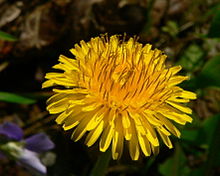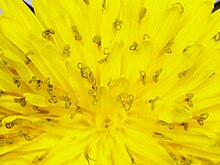
Back Аигьырга Abkhazian طرخشقون Arabic طرخشقون ARZ Taraxacum AST Zəncirotu Azerbaijani زنجیر اوْتو AZB Бәпембә Bashkir Дзьмухавец Byelorussian Дзьмухавец BE-X-OLD Глухарче Bulgarian
| Taraxacum Temporal range: Miocene–recent
| |
|---|---|

| |

| |
| A dandelion flower head composed of numerous small florets (top). The seedhead is shown below it. | |
| Scientific classification | |
| Kingdom: | Plantae |
| Clade: | Tracheophytes |
| Clade: | Angiosperms |
| Clade: | Eudicots |
| Clade: | Asterids |
| Order: | Asterales |
| Family: | Asteraceae |
| Subfamily: | Cichorioideae |
| Tribe: | Cichorieae |
| Subtribe: | Crepidinae |
| Genus: | Taraxacum F. H. Wigg. |
| Type species | |
| Taraxacum officinale[2] | |
| Species | |
|
See text | |
| Synonyms | |
|
List
| |

Taraxacum (/təˈræksəkəm/)[3] is a large genus of flowering plants in the family Asteraceae, which consists of species commonly known as dandelions. The scientific and hobby study of the genus is known as taraxacology.[4] The genus is native to Eurasia and North America, but the two most commonplace species worldwide, T. officinale (the common dandelion) and T. erythrospermum (the red-seeded dandelion), were introduced from Europe into North America, where they now propagate as wildflowers.[5] The plant thrives in temperate regions and can be found in yards, gardens, sides of roads, among crops, and in many other habitats.[6] Both species are edible in their entirety[a] and have a long history of consumption.[7] The common name dandelion (/ˈdændəlaɪ.ən/ DAN-də-ly-ən; from French dent-de-lion 'lion's tooth', referring to the jagged leaves) is also given to specific members of the genus.[8]
Like other members of the family Asteraceae, they have very small flowers collected together into a composite flower head. Each single flower in a head is called a floret. In part due to their abundance, along with being a generalist species, dandelions are one of the most vital early spring nectar sources for a wide host of pollinators.[9] Many Taraxacum species produce seeds asexually by apomixis, where the seeds are produced without pollination, resulting in offspring that are genetically identical to the parent plant.[10]
In general, the leaves are 50–250 mm (2–10 in) long or longer, simple, lobed-to-pinnatisect, and form a basal rosette above the central taproot. The flower heads are yellow to orange coloured, and are open in the daytime, but closed at night. The heads are borne singly on a hollow stem (scape) that is usually leafless and rises 10–100 mm (3⁄8–3+7⁄8 in) or more[5] above the leaves. Stems and leaves exude a white, milky latex when broken. A rosette may produce several flowering stems at a time. The flower heads are 20–50 mm (3⁄4–2 in) in diameter and consist entirely of ray florets. The flower heads mature into spherical seed heads sometimes called blowballs[11] or clocks (in both British and American English)[12][13][14][15] containing many single-seeded fruits called cypselae, similar to achenes. Each cypsela is attached to a pappus of fine hair-like material which enables anemochorous (wind-aided) dispersal over long distances.[citation needed]
The flower head is surrounded by bracts (sometimes mistakenly called sepals) in two series. The inner bracts are erect until the seeds mature, then flex downward to allow the seeds to disperse. The outer bracts are often reflexed downward, but remain appressed in plants of the sections Palustria and Spectabilia. Between the pappus and the achene is a stalk called a beak, which elongates as the fruit matures. The beak breaks off from the achene quite easily, separating the seed from the parachute.[16]
- ^ Rubar Hussein M. Salih, Ľuboš Majeský, Trude Schwarzacher, et al. (9 February 2017). "Complete chloroplast genomes from apomictic Taraxacum (Asteraceae): Identity and variation between three microspecies". PLOS ONE. 12 (2). e0168008. Bibcode:2017PLoSO..1268008M. doi:10.1371/journal.pone.0168008. PMC 5300115. PMID 28182646.
- ^ Adrian John Richards (1985). "Sectional nomenclature in Taraxacum (Asteraceae)". Taxon. 34 (4): 633–644. doi:10.2307/1222201. JSTOR 1222201.
- ^ "Taraxacum". Merriam-Webster.com Dictionary.
- ^ Greenwood B (2015). "Don't Dismiss the Dandelion".
- ^ a b Brouillet L. "Taraxacum F. H. Wiggers, Prim. Fl. Holsat. 56. 1780". Flora of North America.
- ^ Boguś MI, Wrońska AK, Kaczmarek A, et al. (20 January 2023). "A comprehensive analysis of chemical and biological pollutants (natural and anthropogenic origin) of soil and dandelion (Taraxacum officinale) samples". PLOS ONE. 18 (1): e0280810. Bibcode:2023PLoSO..1880810B. doi:10.1371/journal.pone.0280810. ISSN 1932-6203. PMC 9858760. PMID 36662824.
- ^ "Wild About Dandelions". Mother Earth News. 1 April 2008.
- ^ Simons P (25 May 2012). "Plantwatch: The remarkable 'dent de lion' is becoming much more fierce". The Guardian. ISSN 0261-3077. Retrieved 29 April 2024.
- ^ "Let dandelions grow. Bees, beetles and birds need them". The Guardian. 12 May 2015.
- ^ Doll J, Trower T. "Dandelion". WeedScience. University of Wisconsin. Archived from the original on 22 October 2008.
- ^ "blowball". McGraw-Hill Dictionary of Scientific & Technical Terms (6th ed.). McGraw-Hill Companies. 2003. Retrieved 26 January 2013.
- ^ "blowball". CollinsDictionary.com. HarperCollins.
- ^ "blowball". InfoPlease Dictionary.
- ^ "dandelion clock". Longman English Dictionary Online. Pearson. Retrieved 2 June 2019.
- ^ "clock". The American Heritage Dictionary of the English Language (5th ed.). HarperCollins.
- ^ "Engineers uncover secret 'thinking' behind dandelions' seed dispersal | Imperial News | Imperial College London". Imperial News. 1 June 2022. Retrieved 13 May 2024.
Cite error: There are <ref group=lower-alpha> tags or {{efn}} templates on this page, but the references will not show without a {{reflist|group=lower-alpha}} template or {{notelist}} template (see the help page).
© MMXXIII Rich X Search. We shall prevail. All rights reserved. Rich X Search